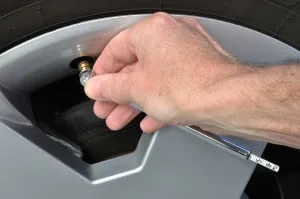 When is the last time you checked your vehicle’s tire pressure? Hopefully you checked before hitting the road this summer, but if you logged a lot of miles on your trip, you might want to check again before you run your next errand. In fact, Safecar.gov reports that you should check your vehicle’s tire pressure at least once a month, as tires lose air over time and can lose air suddenly if your drive over an object or hit a curb when parking.
When is the last time you checked your vehicle’s tire pressure? Hopefully you checked before hitting the road this summer, but if you logged a lot of miles on your trip, you might want to check again before you run your next errand. In fact, Safecar.gov reports that you should check your vehicle’s tire pressure at least once a month, as tires lose air over time and can lose air suddenly if your drive over an object or hit a curb when parking.
Checking your vehicle’s tire pressure isn’t as simple as looking at your tires, as a tire that’s 40% under-inflated looks quite similar to a properly inflated tire, according to Safecar.gov. However, checking the pressure in your tires isn’t difficult either. All you need is an accurate tire pressure gauge, which you can find at tire dealerships, auto supply stores, and other retail outlets.
To measure and maintain the pressure in your tires, follow these tips from Safecar.gov and DMV.org:
- Observe the tire pressure and vehicle load limits on tire information and vehicle certification labels found within your vehicle (such as inside the driver’s door) or in the vehicle owner’s manual.
- Measure tire pressure when your tires are “cold,” or when they have not been driven on for at least three hours. A vehicle manufacturer’s recommended tire inflation pressure is the proper pounds per square inch (PSI) when a tire is cold.
- Place the air pressure gauge evenly onto the tire valve stem on the side of the tire. Press the gauge firmly down onto the valve stem to stop airflow and give your gauge a reading.
- Check all four tires and the spare tire so that you know it’s ready to use when you need it and make sure all tires have the same pressure.
- Release air in an over-inflated tired by gently pressing on the valve stem with the edge of your tire gauge until you get the correct pressure
- Add missing pounds of air pressure to an under-inflated tire using an air hose at a gas station. The difference between the measure tire pressure and the correct tire pressure is the amount of pounds of pressure you will add.
- Don’t inflate your tires five PSI more or less than recommended, as over- and under- inflating your tires can wear them out quicker and result in tire failure.
